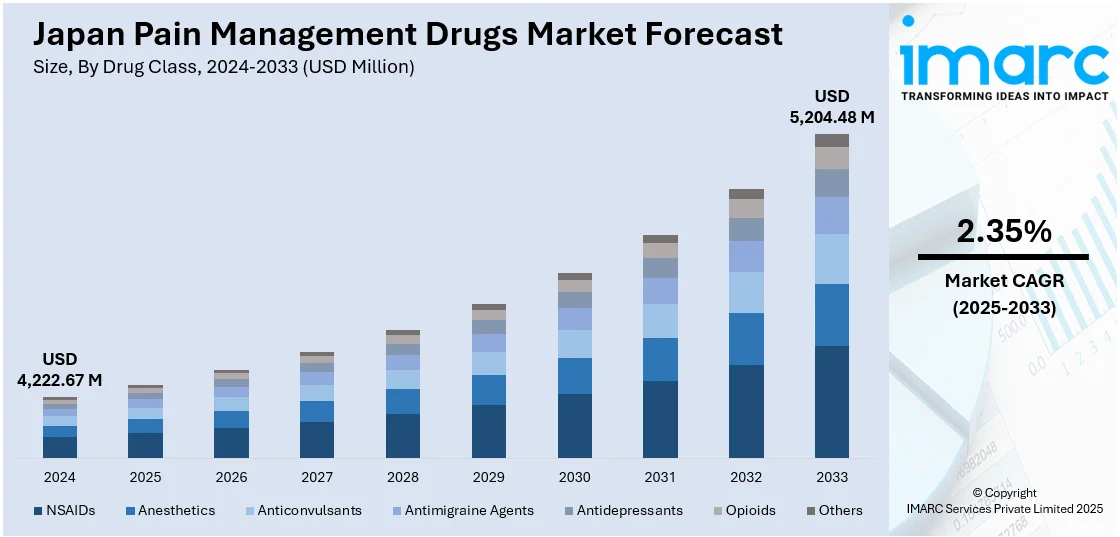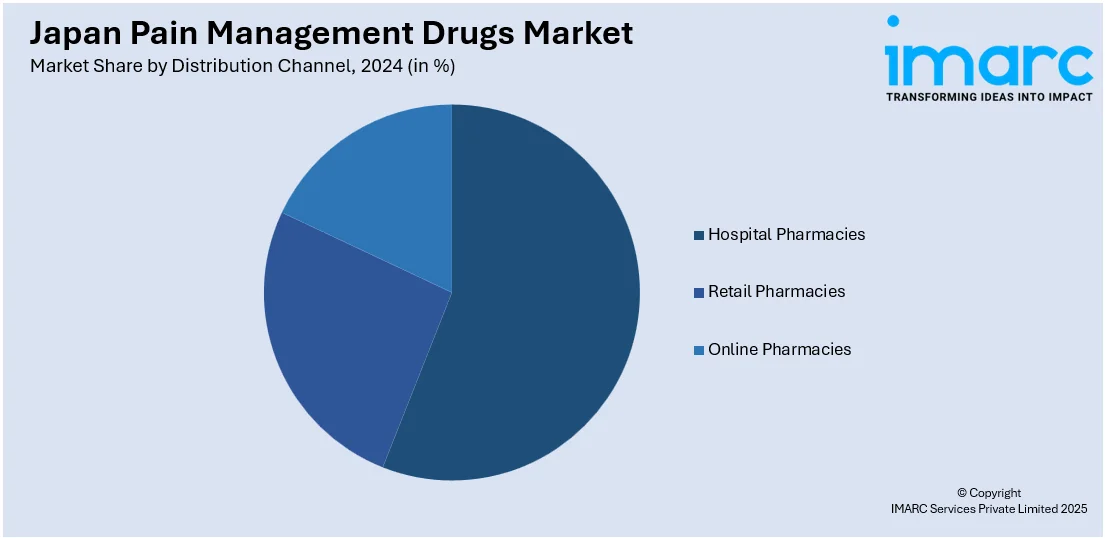
Japan Pain Management Drugs Market Size, Share, Trends and Forecast by Drug Class, Indication, Distribution Channel, and Region, 2025-2033
Japan Pain Management Drugs Market Overview:
The Japan pain management drugs market size reached USD 4,222.67 Million in 2024. Looking forward, IMARC Group expects the market to reach USD 5,204.48 Million by 2033, exhibiting a growth rate (CAGR) of 2.35% during 2025-2033. The market is experiencing significant growth, driven by an aging population, innovation in drug delivery, and rising demand for non-opioid treatments. Moreover, strict regulations and healthcare reforms continue to shape market expansion and therapeutic advancements nationwide.
|
Report Attribute
|
Key Statistics
|
|---|---|
|
Base Year
|
2024 |
|
Forecast Years
|
2025-2033
|
|
Historical Years
|
2019-2024
|
| Market Size in 2024 | USD 4,222.67 Million |
| Market Forecast in 2033 | USD 5,204.48 Million |
| Market Growth Rate 2025-2033 | 2.35% |
Japan Pain Management Drugs Market Trends:
Rising Geriatric Population
Japan’s aging population is a significant driver of sustained demand in the pain management drugs industry. The increasing number of elderly individuals is directly influencing Japan pain management drugs market growth, as age-related health issues such as osteoarthritis, chronic back pain, and neuropathic conditions become more prevalent. According to the reports, Japan's elderly population reached a record 36.25 million, making up 29.3% of the total population. Women aged 65 or older account for 20.53 million, while men total 15.72 million. Additionally, 9.14 million elderly are employed, reflecting ongoing demographic challenges as the population declines for the 13th consecutive year. With life expectancy among the highest globally, a large segment of the population requires long-term, consistent pain relief therapies. These often include a combination of NSAIDs, antidepressants, and specialized treatments tailored to older adults, who are also more vulnerable to drug sensitivity and side effects. Healthcare providers are adapting by prioritizing safer, lower-dose formulations and monitoring protocols. Additionally, the rising rate of age-related surgeries, such as joint replacements, is fueling demand for post-operative pain medications. As Japan’s demographic shift deepens, this trend will continue to increase the Japan pain management drugs market share across therapeutic categories.

Innovation in Drug Delivery and Formulation
Japanese pharmaceutical companies are actively innovating drug delivery methods to improve treatment outcomes and enhance patient comfort. With a growing focus on chronic pain and elderly care, firms are shifting toward advanced options such as transdermal patches, extended-release tablets, and topical gels or sprays. These alternatives allow for more precise dosing, sustained pain relief, and reduced gastrointestinal or systemic side effects, which are particularly important for older adults and long-term users. Innovation in formulation also includes development of combination drugs and novel compounds that target pain more efficiently while reducing dependency risks. For instance, in November 2024, Eisai Co., Ltd. launched Rozebalamin® for Injection 25 mg (mecobalamin) in Japan, to slow functional impairment and address pain in amyotrophic lateral sclerosis (ALS) patients. Approved in September, it follows a Phase III trial with 130 patients. These advancements are not only improving adherence but also expanding product offerings across therapeutic categories. As regulatory bodies support safer alternatives and healthcare professionals adopt newer delivery formats, innovation is expected to play a key role in shaping the Japan pain management drugs market outlook in the coming years.
Japan Pain Management Drugs Market Segmentation:
IMARC Group provides an analysis of the key trends in each segment of the market, along with forecasts at the regional level for 2025-2033. Our report has categorized the market based on drug class, indication, and distribution channel.
Drug Class Insights:
- NSAIDs
- Anesthetics
- Anticonvulsants
- Antimigraine Agents
- Antidepressants
- Opioids
- Others
The report has provided a detailed breakup and analysis of the market based on the drug class. This includes NSAIDs, anesthetics, anticonvulsants, antimigraine agents, antidepressants, opioids, and others.
Indication Insights:
- Musculoskeletal Pain
- Surgical and Trauma Pain
- Cancer Pain
- Neuropathic Pain
- Migraine Pain
- Obstetrical Pain
- Fibromyalgia Pain
- Burn Pain
- Dental/Facial Pain
- Pediatric Pain
- Others
A detailed breakup and analysis of the market based on the indication have also been provided in the report. This includes musculoskeletal pain, surgical and trauma pain, cancer pain, neuropathic pain, migraine pain, obstetrical pain, fibromyalgia pain, burn pain, dental/facial pain, pediatric pain, and others.
Distribution Channel Insights:

- Hospital Pharmacies
- Retail Pharmacies
- Online Pharmacies
A detailed breakup and analysis of the market based on the distribution channel have also been provided in the report. This includes hospital pharmacies, retail pharmacies, and online pharmacies.
Regional Insights:
- Kanto Region
- Kansai/Kinki Region
- Central/Chubu Region
- Kyushu-Okinawa Region
- Tohoku Region
- Chugoku Region
- Hokkaido Region
- Shikoku Region
The report has also provided a comprehensive analysis of all the major regional markets, which include Kanto Region, Kansai/Kinki Region, Central/Chubu Region, Kyushu-Okinawa Region, Tohoku Region, Chugoku Region, Hokkaido Region, and Shikoku Region.
Competitive Landscape:
The market research report has also provided a comprehensive analysis of the competitive landscape. Competitive analysis such as market structure, key player positioning, top winning strategies, competitive dashboard, and company evaluation quadrant has been covered in the report. Also, detailed profiles of all major companies have been provided.
Japan Pain Management Drugs Market News:
- In October 2024, Akelos Inc. announced that the Japan Patent Office approved its patent application for a lead compound aimed at treating chronic pain, originally developed at Weill Cornell Medicine. This milestone complements its existing US patent and supports Akelos's mission to provide non-opioid alternatives amid the opioid crisis.
- In December 2023, Allay Therapeutics announced its partnership with Maruishi Pharmaceutical to develop and commercialize its investigational non-opioid pain relief drug in Japan. The agreement includes upfront payments, equity investment, and potential milestone payments, as Allay retains rights outside Japan. The drug aims to enhance post-surgical pain management after total knee arthroplasty.
Japan Pain Management Drugs Market Report Coverage:
| Report Features | Details |
|---|---|
| Base Year of the Analysis | 2024 |
| Historical Period | 2019-2024 |
| Forecast Period | 2025-2033 |
| Units | Million USD |
| Scope of the Report |
Exploration of Historical Trends and Market Outlook, Industry Catalysts and Challenges, Segment-Wise Historical and Future Market Assessment:
|
| Drug Classes Covered | NSAIDs, Anesthetics, Anticonvulsants, Antimigraine Agents, Antidepressants, Opioids, Others |
| Indications Covered | Musculoskeletal Pain, Surgical and Trauma Pain, Cancer Pain, Neuropathic Pain, Migraine Pain, Obstetrical Pain, Fibromyalgia Pain, Burn Pain, Dental/Facial Pain, Pediatric Pain, Others |
| Distribution Channels Covered | Hospital Pharmacies, Retail Pharmacies, Online Pharmacies |
| Regions Covered | Kanto Region, Kansai/Kinki Region, Central/Chubu Region, Kyushu-Okinawa Region, Tohoku Region, Chugoku Region, Hokkaido Region, Shikoku Region |
| Customization Scope | 10% Free Customization |
| Post-Sale Analyst Support | 10-12 Weeks |
| Delivery Format | PDF and Excel through Email (We can also provide the editable version of the report in PPT/Word format on special request) |
Key Questions Answered in This Report:
- How has the Japan pain management drugs market performed so far and how will it perform in the coming years?
- What is the breakup of the Japan pain management drugs market on the basis of drug class?
- What is the breakup of the Japan pain management drugs market on the basis of indication?
- What is the breakup of the Japan pain management drugs market on the basis of distribution channel?
- What is the breakup of the Japan pain management drugs market on the basis of region?
- What are the various stages in the value chain of the Japan pain management drugs market?
- What are the key driving factors and challenges in the Japan pain management drugs market?
- What is the structure of the Japan pain management drugs market and who are the key players?
- What is the degree of competition in the Japan pain management drugs market?
Key Benefits for Stakeholders:
- IMARC’s industry report offers a comprehensive quantitative analysis of various market segments, historical and current market trends, market forecasts, and dynamics of the Japan pain management drugs market from 2019-2033.
- The research report provides the latest information on the market drivers, challenges, and opportunities in the Japan pain management drugs market.
- Porter's five forces analysis assist stakeholders in assessing the impact of new entrants, competitive rivalry, supplier power, buyer power, and the threat of substitution. It helps stakeholders to analyze the level of competition within the Japan pain management drugs industry and its attractiveness.
- Competitive landscape allows stakeholders to understand their competitive environment and provides an insight into the current positions of key players in the market.
Need more help?
- Speak to our experienced analysts for insights on the current market scenarios.
- Include additional segments and countries to customize the report as per your requirement.
- Gain an unparalleled competitive advantage in your domain by understanding how to utilize the report and positively impacting your operations and revenue.
- For further assistance, please connect with our analysts.
 Request Customization
Request Customization
 Speak to an Analyst
Speak to an Analyst
 Request Brochure
Request Brochure
 Inquire Before Buying
Inquire Before Buying




.webp)




.webp)












